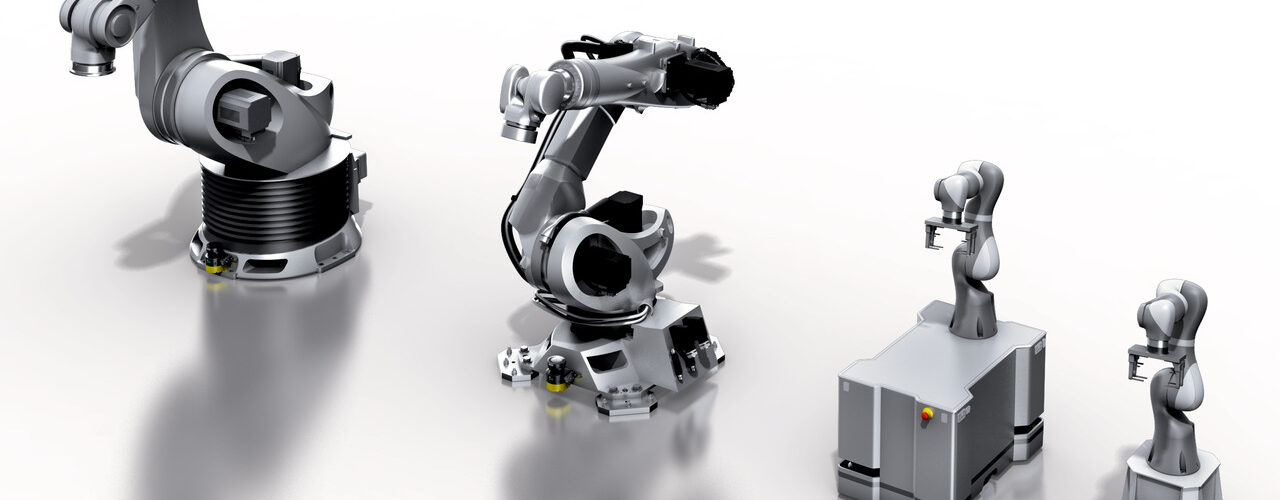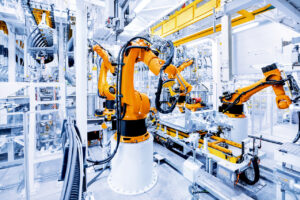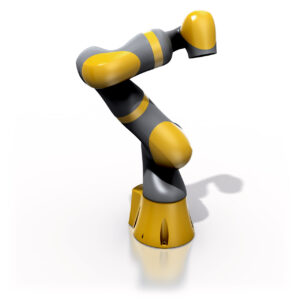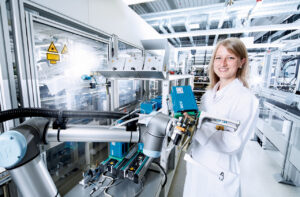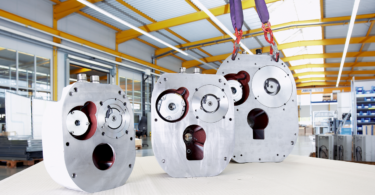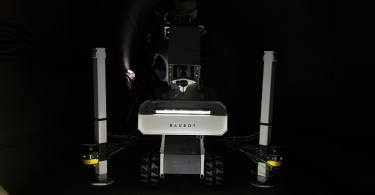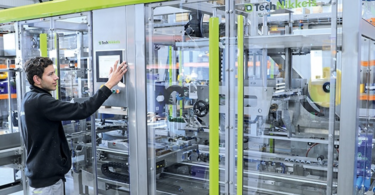Breaking down the different industrial robot types and how they can work for you
Manufacturers use a variety of robots in their operations, each with its own specific capabilities and functions. We’re discussing some of the most common industrial robot types used in manufacturing, and which one may work best for your application.
At the end, we’ll also talk sensors. As the backbone of most manufacturing processes, sensors are a necessary component for the safe and efficient operation of robots. Let’s discuss the seven types of robots!
Articulated Robots
Articulated robots are an industrial robot type that have a series of joints, allowing them to move like a human arm. These joints are typically rotary joints that can move in a range of motion, providing flexibility and maneuverability for the robot.
The arm of an articulated robot typically consists of several segments, with each segment attached to a joint. The segments can be straight or curved, and the number of segments and joints can vary depending on the specific robot model and application. The end of the arm typically has a tool or end effector attached, such as a gripper or dedicated tool for a specific operation.
Articulated robots are versatile and can perform a wide range of tasks, such as welding, material handling, assembly, and inspection. They can work in tight spaces and can reach over obstacles, making them ideal for complex manufacturing operations. They also provide more freedom than any other robot type. Their ability to cover several movements makes them more adaptable to changes in the production process or workpieces.
Articulated robots can usually do high payloads, with the highest payload capacity currently at 2300kg with a FANUC robot. They can also work at high speeds with a high degree of precision, improving production efficiency and quality. However, other types of robots typically perform at a higher speed than an articulated robot does.
SCARA Robots
SCARA robots are an industrial robot type that have a similar arm structure to articulated robots, but with a fixed base. The acronym SCARA stands for Selective Compliance Assembly Robot Arm.
The arm of a SCARA robot consists of two parallel joints that allow the arm to move in a horizontal plane, with a third joint that allows the arm to move up and down. This design provides the robot with a greater level of rigidity and accuracy, making it well-suited for applications that require precise movements in a horizontal plane, such as pick-and-place operations.
SCARA robots are a popular choice for manufacturing applications where precision and speed are essential, often used for assembly, inspection, and packaging applications, where a high level of precision and repeatability is required. They can also work at high speeds, making them ideal for high-volume manufacturing operations. They offer a high level of accuracy, repeatability, and flexibility, making them a valuable tool for manufacturers seeking to improve their production efficiency and output.
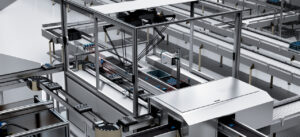 Cartesian Robots
Cartesian Robots
Cartesian robots, also known as gantry robots or linear robots, are a type of industrial robot that move in a rectangular coordinate system, creating a three-dimensional cubic envelope of space to work within. The name “Cartesian” comes from the Cartesian coordinate system used to describe positions in space.
These typically consist of a stationary base and an overhead gantry that moves along the X and Y axes. The Z axis is provided by a vertical column that moves up and down, often with a tool or end effector attached. Cartesian robots are known for their ability to provide precise and repeatable movements, making them well-suited for applications that require high levels of accuracy.
Most often used for pick-and-place operations, material handling, and assembly applications, they can work at high speeds and can handle heavy loads, making them ideal for high-volume manufacturing operations. They can also be easily customized to fit specific manufacturing needs, such as the addition of vision systems for inspection or guidance.
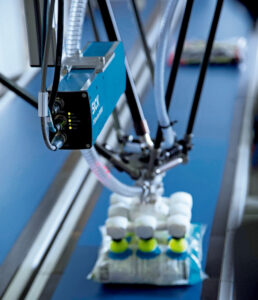 Delta Robots
Delta Robots
This industrial robot type is most often used for pick-and-place operations, packaging, and assembly applications, where a high degree of precision and speed is required. They can work at very high speeds, often exceeding 200 cycles per minute, and can handle small, lightweight items with great accuracy.
They are commonly used in the food and pharmaceutical industries, where hygiene is critical. Delta robots are also ideal for clean room environments, as they have a sealed design that prevents contamination from entering the workspace.
Collaborative Robots
Collaborative robots, also known as cobots, are a type of robot designed for direct interaction with a human within a defined collaborative workspace. Unlike traditional industrial robots, which typically operate behind safety barriers, cobots are designed to operate in close proximity to human workers without posing a safety risk.
Equipped with a range of safety features, such as sensors and cameras, cobots can detect the presence of humans and adjust movements accordingly. They are also designed to be lightweight and easy to program, allowing them to be quickly deployed in a variety of manufacturing environments.
They are most often used for tasks that are repetitive, dangerous, or difficult for human workers, such as material handling, assembly, and inspection. They can be used to perform a wide range of manufacturing tasks, including welding, painting, and packaging.
Cobots offer several advantages over traditional industrial robots. They are more flexible and can be easily reprogrammed to perform different tasks, making them ideal for small-batch manufacturing operations. They are also more affordable than traditional robots, making them accessible to a wider range of manufacturers.
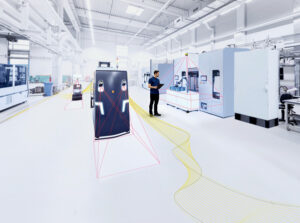 Industrial Mobile Robots (IMR)
Industrial Mobile Robots (IMR)
Mobile robots are equipped with a variety of sensors and systems that allow them to perceive their environment and make decisions based on that information. For example, they may use cameras, LiDAR or ultrasound sensors to detect obstacles or map their surroundings.
In manufacturing, mobile robots are often used for logistics tasks, such as moving materials or products between workstations or to storage locations. They can also be used for quality control and inspection tasks, where they can move around a workspace to inspect products or equipment.
There are several different kinds of IMRs, but to sum it up easily:
- AGV = mobile platform that follows predefined path
- AMR = mobile platform that navigates autonomously
In addition, there is one kind of IMR that has a manipulator attached to it, a Type C IMR. A manipulator is an automatically controlled multipurpose mechanism, programmable in three or more axes, which is fixed to a mobile platform for use in automation applications in an industrial environment.
In general, IMRs offer several advantages over stationary robots as they can cover larger areas and work in environments that may not be accessible to stationary robots. They can also be reprogrammed or reconfigured easily, making them more versatile and adaptable to changing manufacturing needs.
Sensors for Robotics

Position sensors, such as encoders or potentiometers, are used to measure the position of the robot's joints or wheels. This allows the robot to move with high accuracy and precision. Wheel encoders are used in mobile robots to measure the rotation of the robot's wheels. This allows the robot to move with high accuracy and to estimate its position.
 Proximity sensors, such as ultrasonic sensors or laser range finders, are used to detect the presence of objects in the robot's environment. This allows the robot to avoid collisions and operate safely.
Proximity sensors, such as ultrasonic sensors or laser range finders, are used to detect the presence of objects in the robot's environment. This allows the robot to avoid collisions and operate safely.

Vision sensors, such as cameras or 3D scanners, allow the robot to perceive its environment visually. They can be used for tasks such as object recognition, inspection, or navigation.

Safety sensors could include but are not limited to light curtains, area scanners, or safety stops. Light curtains emit a beam of infrared light that extends across the robot's workspace. If a person or object breaks the beam, the robot's motion is automatically stopped. Area scanners use lasers or other technologies to detect the presence of people or objects in the robot's workspace. They can be used to trigger a safety stop or to slow down the robot's motion when a person or object is detected. Emergency stop buttons allow workers to manually stop the robot's motion in the event of an emergency.
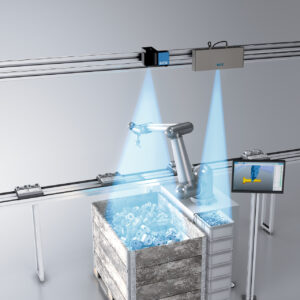
Robot Guidance Systems typically use sensors, such as cameras or laser scanners, to measure the position and orientation of objects or features in the robot's workspace. This information is then used to adjust the robot's movements in real time, allowing it to follow a predetermined path or to adjust its position based on changes in the environment. Robots benefit from using robot guidance systems in a variety of applications, such as pick-and-place operations, assembly tasks, or inspection processes. For example, a vision-based robot guidance system could be used to guide a robot to pick up objects of varying shapes and sizes from a conveyor belt, or to align components for precise assembly.
The choice of robot will depend on the specific task and requirements of the manufacturing operation. Want to learn more about robotics and how sensors can optimize operation?


